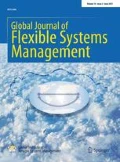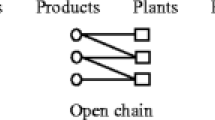Abstract
This study suggests a supply chain design deploying a novel idea from production planning. The idea of capacity bottlenecks is used to improve flexibility in a multi-echelon multi-product supply chain. We suggest an optimization model that focuses on optimal capacity allocations to bottleneck points in order to enhance overall flexibility. The proposed mixed-integer linear programming model minimizes the total cost of facility establishment as well as their utilization and transportation cost. The performance of suggested model is investigated by several test problems with uncertainty in demand, cost, capacity, and product specifications. The results indicate the superiority of the suggested model to the previous flexibility formulation method. According to the numerical results, the proposed model decreases the total supply chain cost by up to 16 % on average. Another advantageous feature of the proposed model is its capability of solving previously insolvable test problems by optimizing flexibility levels.
Similar content being viewed by others
References
Anderson, D. L., & Lee, H. (1999). Synchronized supply chains: The new frontier. ASCET, 6(1), 56–59.
Avittathur, B., & Swamidass, P. (2007). Matching plant flexibility and supplier flexibility: Lessons from small suppliers of US manufacturing plants in India. Journal of Operations Management, 25(3), 717–735.
Baffo, I., Confessore, G., & Stecca, G. (2013). A decentralized model for flow shop production with flexible transportation system. Journal of Manufacturing Systems, 32(1), 68–77.
Baghalian, A., Rezapour, S., & Farahani, R. Z. (2013). Robust supply chain network design with service level against disruptions and demand uncertainties: A real-life case. European Journal of Operational Research, 227(1), 199–215. doi:10.1016/j.ejor.2012.12.017.
Ben-Tal, A., & Nemirovski, A. (2000). Robust solutions of Linear Programming problems contaminated with uncertain data. Mathematical Programming, 88, 411–424.
Calantone, R., & Dröge, C. (1999). Supply chain flexibility: An empirical study. Journal of Supply Chain Management, 35(3), 16–24.
Chase, R. B., Aquilano, N. J., & Jacobs, F. R. (2001). Operations management for competitive advantage. Boston: Irwin McGraw-Hill.
Christopher, M. (2000). The agile supply chain: Competing in volatile markets. Industrial Marketing Management, 29(1), 37–44.
Corominas, A. (2013). Supply chains: What they are and the new problems they raise. International Journal of Production Research, 51(23–24), 6828–6835.
D’Souza, D. E., & Williams, F. P. (2000). Toward a taxonomy of manufacturing flexibility dimensions. Journal of Operations Management, 18(5), 577–593.
Dubey, R., Gunasekaran, A., & Childe, S. J. (2015). The design of a responsive sustainable supply chain network under uncertainty. The International Journal of Advanced Manufacturing Technology, 80(1–4), 427–445.
Duclos, L. K., Vokurka, R. J., & Lummus, R. R. (2003). A conceptual model of supply chain flexibility. Industrial Management & Data Systems, 103(6), 446–456.
Esmaeilikia, M., Fahimnia, B., Sarkis, J., Govindan, K., Kumar, A., & Mo, J. (2014). A tactical supply chain planning model with multiple flexibility options: An empirical evaluation. Annals of Operations Research, Advance Online Publication, 1–26. doi:10.1007/s10479-013-1513-2.
Fernandes, R., Gouveia, J. B., & Pinho, C. (2012). Product mix strategy and manufacturing flexibility. Journal of Manufacturing Systems, 31(3), 301–311.
Fisher, M. L. (1997). What is the right supply chain for your product? Harvard Business Review, 75, 105–117.
Fuller, J. B., O’Conor, J., & Rawlinson, R. (1993). Tailored logistics: The next advantage. Harvard Business Review, 71(3), 87–98.
Gilmore, J. H., & Pine, B. J. (1997). The four faces of mass customization. Harvard Business Review, 75(1), 91–101.
Gunasekaran, A., Patel, C., & Tirtiroglu, E. (2001). Performance measures and metrics in a supply chain environment. International Journal of Operations & Production Management, 21(1/2), 71–87.
Hall, D. T., & Parker, V. A. (1993). The role of workplace flexibility in managing diversity. Organizational Dynamics, 22(1), 5–18.
Hallgren, M., & Olhager, J. (2009). Flexibility configurations: Empirical analysis of volume and product mix flexibility. Omega, 37(4), 746–756.
Hasuike, T., & Ishii, H. (2009). On flexible product-mix decision problems under randomness and fuzziness. Omega, 37(4), 770–787.
Jordan, J. A., & Michel, F. J. (2000). Next generation manufacturing: Methods and techniques. New York: Wiley.
Kaur, H., Singh, S. P., & Glardon, R. (2015). An integer linear program for integrated supplier selection: A sustainable flexible framework. Global Journal of Flexible Systems Management. doi:10.1007/s40171-015-0105-1.
Khatwani, G., Singh, S. P., Trivedi, A., & Chauhan, A. (2015). Fuzzy-TISM: A fuzzy extension of TISM for group decision making. Global Journal of Flexible Systems Management, 16(1), 97–112.
Koste, L. L., & Malhotra, M. K. (1999). A theoretical framework for analyzing the dimensions of manufacturing flexibility. Journal of Operations Management, 18(1), 75–93.
Kume, K., & Fujiwara, T. (2015). Production flexibility of real options in daily supply chain. Global Journal of Flexible Systems Management. doi:10.1007/s40171-015-0103-3.
Lai, G., Debo, L. G., & Sycara, K. (2009). Sharing inventory risk in supply chain: The implication of financial constraint. Omega, 37(4), 811–825.
Lau, R. (1996). Strategic flexibility: A new reality for world-class manufacturing. SAM Advanced Management Journal, 61, 11–15.
Lee, H. L. (2002). Aligning supply chain strategies with product uncertainties. California Management Review, 44(3), 105–119.
Lee, S. M., & Hong, S. (2002). An enterprise-wide knowledge management system infrastructure. Industrial Management & Data Systems, 102(1), 17–25.
Lee, H. L., Padmanabhan, V., & Whang, S. (2004). Information distortion in a supply chain: The bullwhip effect. Management Science, 50(12_supplement), 1875–1886. doi:10.1287/mnsc.1040.0266.
Lummus, R. R., Duclos, L. K., & Vokurka, R. J. (2003). Supply chain flexibility: Building a new model. Global Journal of Flexible Systems Management, 4(4), 1.
Martínez Sánchez, A., & Pérez, M. P. (2005). Supply chain flexibility and firm performance: A conceptual model and empirical study in the automotive industry. International Journal of Operations & Production Management, 25(7), 681–700.
Mason-Jones, R., Naylor, B., & Towill, D. R. (2000). Lean, agile or leagile? Matching your supply chain to the marketplace. International Journal of Production Research, 38(17), 4061–4070.
Miles, R. E. (1989). Adapting to technology and competition—a new industrial-relations system for the 21st-century. California Management Review, 31(2), 9–28.
Petridis, K. (2015). Optimal design of multi-echelon supply chain networks under normally distributed demand. Annals of Operations Research, 227(1), 63–91.
Prater, E., Biehl, M., & Smith, M. A. (2001). International supply chain agility-Tradeoffs between flexibility and uncertainty. International Journal of Operations & Production Management, 21(5/6), 823–839.
Radjou, N. (2000). Deconstruction of the supply chain. Supply Chain Management Review, 4(5), 30–38.
Rajabalipour Cheshmehgaz, H., Desa, M. I., & Wibowo, A. (2013). A flexible three-level logistic network design considering cost and time criteria with a multi-objective evolutionary algorithm. Journal of Intelligent Manufacturing, 24(2), 277–293.
Reddy, S. B., & Reddy, R. (2002). Competitive agility and the challenge of legacy information systems. Industrial Management & Data Systems, 102(1), 5–16.
Ricker, F., & Kalakota, R. (1999). Order fulfillment: The hidden key to e-commerce success. Supply Chain Management Review, 11(3), 60–70.
Sabri, E. H., & Beamon, B. M. (2000). A multi-objective approach to simultaneous strategic and operational planning in supply chain design. Omega, 28(5), 581–598.
Sahu, A. K., Sahu, S. K., Datta, S., & Mahapatra, S. S. (2015). Supply chain flexibility assessment and decision-making: A fuzzy intelligent approach. International Journal of Business Excellence, 8(6), 675–699.
Santoso, T., Ahmed, S., Goetschalckx, M., & Shapiro, A. (2005). A stochastic programming approach for supply chain network design under uncertainty. European Journal of Operational Research, 167(1), 96–115.
Schütz, P., Tomasgard, A., & Ahmed, S. (2009). Supply chain design under uncertainty using sample average approximation and dual decomposition. European Journal of Operational Research, 199(2), 409–419.
Seebacher, G., & Winkler, H. (2015). A capability approach to evaluate supply chain flexibility. International Journal of Production Economics, 167, 177–186.
Simchi-Levi, D. (2000). Designing and managing the supply chain. New York: Irwin McGraw-hill.
Singh, R. K., & Acharya, P. (2013). Supply chain flexibility: A frame work of research dimensions. Global Journal of Flexible Systems Management, 14(3), 157–166.
Slack, N. (1987). The flexibility of manufacturing systems. International Journal of Operations & Production Management, 7(4), 35–45.
Sushil, (2009). Interpretive ranking process. Global Journal of Flexible Systems Management, 10(4), 1–10.
Sushil, (2012). Multiple perspectives of flexible systems management. Global Journal of Flexible Systems Management, 13(1), 1–2.
Swafford, P. M., Ghosh, S., & Murthy, N. (2006). The antecedents of supply chain agility of a firm: Scale development and model testing. Journal of Operations Management, 24(2), 170–188.
Swamidass, P. M., & Newell, W. T. (1987). Manufacturing strategy, environmental uncertainty and performance: A path analytic model. Management Science, 33(4), 509–524.
Tat Leung, Y., & Sheen, G. (1993). Resolving deadlocks in flexible manufacturing cells. Journal of Manufacturing Systems, 12(4), 291–304.
Thatte, A. A. (2007). Competitive advantage of a firm through supply chain responsiveness and SCM practices. PhD Dissertation, The University of Toledo.
Tiwari, A. K., Tiwari, A., & Samuel, C. (2015). Supply chain flexibility: A comprehensive review. Management Research Review, 38(7), 767–792.
Tiwari, A. K., Tiwari, A., Samuel, C., & Bhardwaj, P. (2013). Procurement flexibility as a tool for supplier selection in disastrous environments. Global Journal of Flexible Systems Management, 14(4), 211–223.
Vokurka, R. J., & O’Leary-Kelly, S. W. (2000). A review of empirical research on manufacturing flexibility. Journal of Operations Management, 18(4), 485–501.
Voudouris, V. T., & Consulting, A. (1996). Mathematical programming techniques to debottleneck the supply chain of fine chemical industries. Computers & Chemical Engineering, 20, S1269–S1274.
Ward, P. T., & Duray, R. (2000). Manufacturing strategy in context: Environment, competitive strategy and manufacturing strategy. Journal of Operations Management, 18(2), 123–138.
Ward, P. T., Duray, R., Keong Leong, G., & Sum, C. (1995). Business environment, operations strategy, and performance: An empirical study of Singapore manufacturers. Journal of Operations Management, 13(2), 99–115.
Ware, N. R., Singh, S. P., & Banwet, D. (2014). Modeling flexible supplier selection framework. Global Journal of Flexible Systems Management, 15(3), 261–274.
Yu, H., Zeng, A. Z., & Zhao, L. (2009). Single or dual sourcing: decision-making in the presence of supply chain disruption risks. Omega, 37(4), 788–800.
Author information
Authors and Affiliations
Corresponding author
Rights and permissions
About this article
Cite this article
Kazemian, I., Aref, S. Multi-echelon Supply Chain Flexibility Enhancement Through Detecting Bottlenecks. Glob J Flex Syst Manag 17, 357–372 (2016). https://doi.org/10.1007/s40171-016-0130-8
Received:
Accepted:
Published:
Issue Date:
DOI: https://doi.org/10.1007/s40171-016-0130-8




